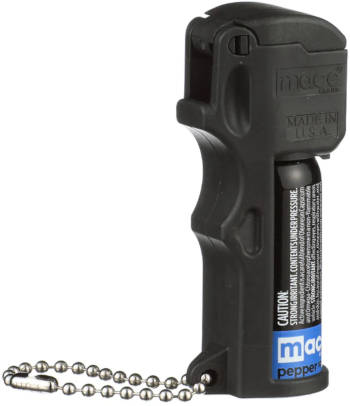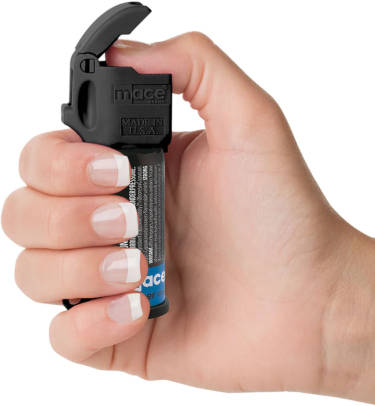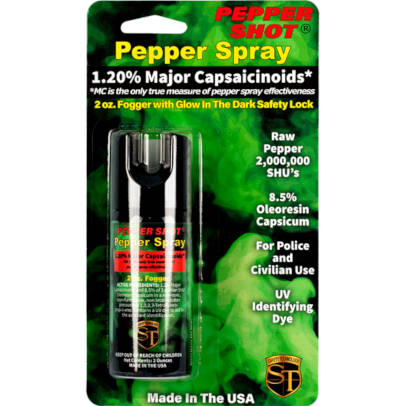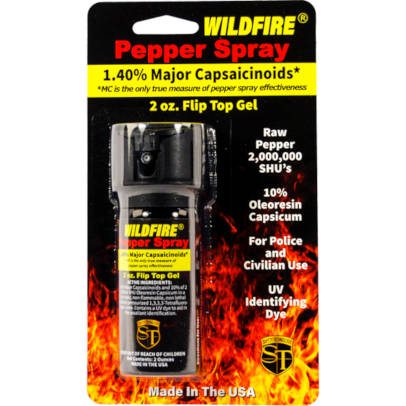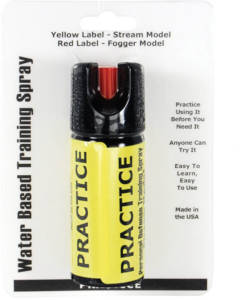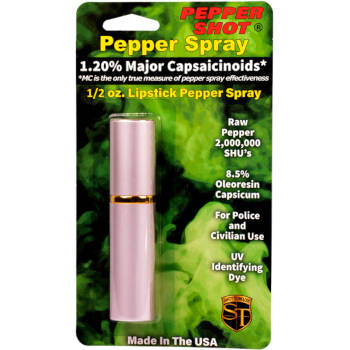How to Use Pepper Spray
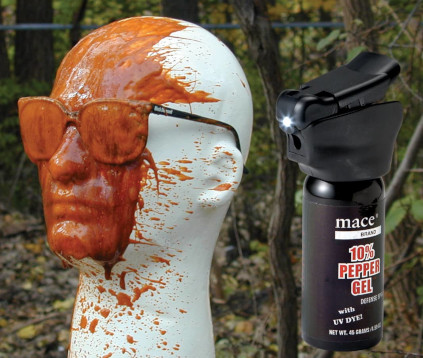
Understanding Pepper Spray
Pepper spray is a non-lethal personal safety tool that emits a concentrated solution containing oleoresin capsicum, a natural compound in chili peppers. Once it comes in contact with the mucous membrane of the eyes, nose, or mouth, it causes temporary blindness, coughing and choking, and an intense burning sensation on the skin.
To better understand the effects of pepper spray, think of your most recent encounter with spicy foods. Did you ever regret ordering something too spicy? Remember how uncomfortable and even painful the burning sensation can be? Now, imagine this sensation intensified a hundred times. This is precisely what someone feels after being sprayed with pepper spray, except they cannot run away from it.
As such, pepper spray is a highly effective self-defense tool that can help ward off attackers without causing any permanent damage to them. Even though pepper sprays are not lethal weapons, they should be used judiciously and responsibly based on the level of threat one faces.
- A study conducted in 2000 by the International Association of Chiefs of Police demonstrated a 93% effectiveness rate for pepper spray in reducing physical assaults.
- According to a 2012 National Institute of Justice-funded study, incidents involving the use of pepper spray by law enforcement resulted in a statistically significant reduction in injuries to both officers and suspects.
- The US Department of Justice estimates that approximately 14 million people worldwide have purchased pepper spray, indicating its popularity as a non-lethal self-defense option.
Types and Dispersal Patterns
Pepper sprays come in different types and dispersal patterns designed for specific use cases. The type determines the concentration of OC within the solution, while the pattern affects its range and coverage area. Here are the four main types of pepper sprays:
Stream: A steady stream of liquid that shoots out like a water gun at high pressure. It can travel up to 20 feet to hit a small target with good accuracy. Stream-type sprays require precision targeting skills to aim for the eyes, as there's little room for error. They're best used in open spaces or against lone attackers.
Mace Triple Action Enhanced with Tear Gas
The popular Mace Brand of Pepper Sprays has an 11 gram stream mace spray that can reach up to 10 feet.
However, if you're not comfortable with using stream sprays, it's best to opt for a different type.
Fog: A mist that shoots out like a showerhead, creating a cloud of pepper spray droplets that disperse over a large area. It provides more coverage and can affect multiple attackers at once. However, the downside is that the spread is unpredictable, and you might also be exposed to the spray yourself. Fog-type sprays work best in enclosed spaces or against crowds.
Pepper Shot 1.2% MC 2 oz pepper spray fogger
The Pepper Shot brand of Pepper Sprays have 2 ounce formula foggers that emit up to 10 bursts in a cone-shaped pattern.
Imagine being inside a sauna where hot water is continuously poured onto rocks to create steam. The steam fills the whole space, making it difficult to breathe or see. This is similar to how fog sprays work.
Gel: A thick gel-like substance that sticks to the attacker's face and clothes on contact. It's less likely to blow back in your face or spread through the air since it doesn't atomize like other sprays. Gel-type sprays are effective against wind and rain conditions but may require additional time to take effect.
Wildfire Flip-Top Gel
The Wildfire Pepper Gel Sprays are equipped with UV dye for identifying attackers and have an ergonomic flip-top design for easy handling and safety.
Some argue that gel sprays are more challenging to use in stressful situations as they require more accuracy when aiming. Actually, you'll be able to see the thick stream exiting the pepper spray canister better than the thinner streams or especially the foggers.
Foam: A whipped foam solution that sticks to the attacker but doesn't dissolve easily. It creates a strong barrier that's difficult to wipe off and minimizes cross-contamination risks. Foam-type sprays work well in close-range situations where physical contact is more likely. It's like applying shaving cream on somebody's face, but instead of a razor blade, you're using pepper spray to protect yourself. Both Foam and Gels are good options for home defense.
Now that you better understand the different types and patterns of pepper sprays available, it's time to learn how to handle and use these products properly.
Proper Handling and Usage Techniques
Proper handling and usage techniques are essential when using pepper spray as a self-defense tool. It is important to familiarize yourself not only with the various types of pepper sprays available but also with how to hold and correctly deploy them in an emergency situation.
Firstly, when carrying pepper spray, you must ensure it is easily accessible. Consider purchasing a keychain or belt-clip/holster model that can be quickly reached in a threatening situation. Knowing the orientation of your canister is also critical. Always make sure the nozzle - where the spray deploys - is pointing away from your body.
Ashley learned this lesson the hard way when she accidentally discharged her new pepper spray while adjusting it in her purse, causing intense eye irritation and respiratory issues for both herself and other crowded subway passengers around her.
Secondly, when deploying pepper spray, aim directly for the attacker's face. Aiming at their eyes while spraying ear to ear provides the best chance of effectiveness. Keep your recessive (or weak) hand up with an open palm facing the assailant like a stop sign and keep the canister close to your body with your dominant hand holding it steady inward. As soon as it's safe to do so, move sideways or run away from the attacker, causing enough distance to ensure your attacker does not get a chance to strike back at you or take your pepper spray from you.
There are different types of dispersal patterns available for pepper sprays such as stream, fog/cone-mist, gel, and foam. Stream-type sprays work best for targeting single threats over further distances, while fog/cone-mist type sprays offer more coverage but at a short range of contact. Gel and foam types tend to impact vision the longest due to their clingy nature.
Think of pepper spray like a fire extinguisher. It's important to know when and how to use it correctly if the need arises. If you have one stowed away in the back of your closet and never give it any attention until a fire starts, its performance may be lacking when you really need it.
Carrying Methods and Safety Features
When it comes to your own self-defense, carrying pepper spray is an effective way to protect yourself. But knowing how to carry it properly is important for maximum safety and effectiveness. There are different carrying methods available, such as keychain models or belt-clip/holster models.
Keychain models are popular because they are lightweight and easy to carry around wherever you go. You can easily attach them to your keys or purse to quickly access your pepper spray when needed. The downside of keychain models is that they may not be as secure as other carrying methods. If you drop your keys or lose your purse, you also lose your pepper spray.
Belt-clip/holster models provide a more secure and accessible method of carrying pepper spray. You can attach the holster to your waistband or belt, making it easily accessible while keeping your hands free. Make sure that the holster fits snugly to avoid any accidental discharge.
Safety features are an important aspect of carrying pepper spray. Most pepper sprays come with a safety lock feature that prevents accidental discharge. It’s crucial to familiarize yourself with the safety lock before taking the spray out with you. Additionally, some models have a flip top or "cop-top" style cap instead of a twist-top actuator, reducing the risk of accidental discharge.
A friend of mine once had a keychain model of pepper spray on her car keys but accidentally sprayed herself while searching through her purse for something else since she didn't realize she caught the trigger on her keychain model; if she had used a belt-clip/holster model instead, this would have never happened and she would've been better protected in case she needed to use the spray in an emergency.
Approaches to Carrying Pepper Spray
Carrying pepper spray is a personal decision. The law in many states allows for it, but carrying a can of pepper spray comes with some important considerations. At the end of the day, you need to weigh the pros and cons of carrying pepper spray yourself based on your safety concerns and local laws. To pursue pepper spray as a self-defense option, there are two approaches to consider when it comes to carrying it: concealed or plainly visible.
Concealing your pepper spray usually means keeping it tucked away on your person, like in a pocket or clipped onto a belt. If you take this approach, you will have the element of surprise if necessary - someone may not realize that you're even armed until they attempt to do something threatening. On the other hand, visibly displaying your pepper spray can act as a deterrent; someone who attempts to victimize you might see it right away and decide against their plan.
Water-Based Practice and Training Pepper Spray
No matter which side of the debate you choose when deciding whether or not to carry pepper spray with you in public, be sure to research the relevant laws first and follow those regulations to stay within legal boundaries. Now let's discuss these techniques in more depth in our next section about "Pepper Spray Techniques."
Key Points
Carrying pepper spray is a personal decision that depends on the individual's safety concerns and local laws. There are two approaches to consider when using it as a form of self-defense – concealing it or displaying it visibly – and researching the relevant laws to determine which approach is best for the individual. Proper usage should be reviewed regularly, and training should be taken to protect oneself efficiently and legally.
Regardless of which carrying method you choose, proper storage is also important. Keep your pepper spray away from heat, moisture, and direct sunlight to prevent any damage or deterioration. It’s also important to regularly check the expiration date and replace your pepper spray when it expires.
Pepper Spray Training
Pepper spray training has become increasingly popular in recent years. Not only does learning how to use pepper spray afford you the peace of mind that comes with knowing you can protect yourself and your loved ones if the need arises, but it’s also an effective and legal way to stop a potential attacker. In addition, pepper spray training is relatively quick and easy to learn, and its non-lethal nature makes it a great option for individuals of all ages.
Common Dangers
We must take note of the dangers that pepper spray can cause when mishandled or used unwisely. If you find yourself in a life-threatening situation and need to respond with self-defense, it is important to understand the possible effects of using a pepper spray product. When used for defensive purposes, there are two main dangers that can arise: chemical burns and inhalation.
Given these potential dangers, it is clear that formalized training on how to safely and effectively use pepper spray is very important for civilians hoping to protect against attackers as well as security personnel who might use one for their jobs. To better understand how one can equip oneself with knowledge of appropriate usage, we will now look at the educational benefits instructor-led training provides.
Educational Benefits of Instructor-led Training
Instructor-led training provides numerous educational benefits, making it an effective way for individuals to learn how to use pepper spray safely and defend themselves. Hands-on instruction from a qualified trainer allows students to combine overview theory with practical application. Approaching the subject from both perspectives reinforces the need for safety precautions and helps build confidence in their ability to deploy pepper spray when needed.
The presence of a policeman, along with a certified instructor, offers students the opportunity to ask questions, assert their feelings about the legal ramifications of using pepper spray, and receive feedback on their practical exercises. This personalized attention enables instructors to demonstrate how to quickly and properly use pepper spray in various situations, as well as highlighting methods of mitigating any adverse effects that can arise through misuse or overuse.
In addition, an instructor-led program will introduce important concepts such as situational awareness and other self-defense strategies that may be beneficial in preventing aggression or de-escalating a volatile situation before a physical confrontation is necessary. For example, body positioning and assertive communication can help identify potential threats early on and encourage them to back down without needing force.
Overall, instructor-led training provides comprehensive education on the legalities and limitations of using pepper spray while emphasizing its proper deployment in dangerous situations and offering alternatives whenever possible. By combining in-depth overviews with hands-on practice within a safe learning environment, a legitimate course will give participants the knowledge they need to respond appropriately when faced with an attack while remaining mindful of all applicable laws regarding self-defense.
Effective Deployment and Aim
When it comes to effectively deploying pepper spray, there are a few key factors to keep in mind. These include proper grip, aim, and technique.
Start by properly holding the pepper spray in your dominant hand. Make sure that you form a fist around it securely for maximum control of the canister. Place your thumb on top of the actuator (trigger) for additional grip and pressure.
Next, extend your recessive (or weak) hand outwards with the palm facing towards the attacker, like a stop sign. This helps you maintain a safe distance between yourself and the attacker. When spraying, aim directly for the eyes in a linear motion, spraying ear to ear. This will help ensure that the largest surface area is covered by the spray.
Think of aiming pepper spray like playing darts. Just like how aiming at the bullseye increases your chances of scoring points, aiming directly at the attacker's eyes increases your chances of successfully hitting them with the spray and impairing their vision.
It’s important to remember that different types of pepper sprays may have different ranges and dispersal patterns. For example, stream-type sprays provide a lot of volume and range but are not as effective when facing multiple attackers. Fog/cone-mist sprays create a cloud-like pattern that can cover a wider area but may be affected by wind direction. Gel and foam sprays create a sticky substance that adheres to the attacker's face, making it difficult for them to wipe off.
Some people question whether or not aiming for the eyes is ethical. However, using pepper spray correctly is legal and morally justifiable within self-defense situations where your life or well-being is at risk. Keep in mind that the goal of using pepper spray is to create an opportunity for you to escape and seek help, and aiming for the eyes helps you reach that goal.
Finally, after deploying pepper spray, move away from the area as quickly as possible to a safe spot. Once there, call the police and report the incident. Make sure that you also move out of the way and sight of any potential attackers who may still be able to see, even if their vision is impaired.
By understanding how to carry pepper spray safely and effectively, you can increase your chances of successfully defending yourself in case of an emergency. In the next section, we will discuss what to do after a pepper spray incident and additional self-defense considerations with pepper sprays.
Aftermath of a Pepper Spray Incident
Using pepper spray should always be a last resort when it comes to self-defense. But in the event that you find yourself in a dangerous situation where you have no choice but to use your spray, it's important to know what can happen afterward.
It's common to experience some level of discomfort after using pepper spray - whether you're the attacker or the victim. Some of the most common reactions include redness, swelling, and stinging sensations around the face and eyes. For those who are particularly sensitive, coughing, sneezing, and difficulty breathing may also occur.
In fact, I remember one story from a friend who accidentally sprayed herself with pepper spray while trying to change her keychain. She told me that within seconds, her eyes began to burn like no other sensation she had ever experienced before. She said she was completely incapacitated for over 20 minutes.
It's important to note that these reactions are temporary and typically subside within 30-45 minutes on their own. However, there are some steps you can take to speed up the healing process.
If you accidentally sprayed yourself with pepper spray, flush your face and eyes with cool water as soon as possible to help alleviate burning and swelling. If you were the victim of an attack and someone else deployed the pepper spray on you, immediately rinse your face and eyes with water or saline solution.
There are also some things you should avoid after being exposed to pepper spray. For example, do not rub your face or eyes as this could spread the spray to other parts of your body. Additionally, it's best to avoid touching any clothing or surfaces that may have come into contact with the spray as it can stay active and potentially reactivate if touched again.
Finally, if you or anyone else experiences severe symptoms such as excessive swelling or difficulty breathing, seek medical attention right away.
Additional Self-Defense Considerations
While pepper spray can be an effective tool for self defense, it's important to understand that it is not a cure-all solution. In fact, relying on pepper spray alone may give you a false sense of security and even put you in more danger in certain situations.
For example, if you're faced with multiple attackers or someone who is determined to harm you, the limited range and capacity of your pepper spray may not be enough to stop them. Additionally, wind direction and other environmental factors can affect how effective your spray will be in certain situations.
It's also important to consider legal restrictions and the potential consequences of using pepper spray. While many states allow the purchase and use of pepper spray as a form of self-defense, there are often regulations around where and how it can be used. In some cases, using pepper spray could result in legal charges if it is deemed excessive force or unnecessary, given the circumstances.
It's similar to carrying a gun - while it can offer protection in certain situations, there are also risks and responsibilities that come with owning and using such a weapon. Proper training and understanding of the laws surrounding self-defense with pepper spray are essential before making the decision to carry it with you.
When considering self-defense options, it's important to have a comprehensive plan that includes not just tools like pepper spray but also awareness of your surroundings and potential dangers, avoidance strategies, and physical skills for defending yourself if necessary.
For example, taking a self-defense class can provide you with valuable skills for protecting yourself without relying solely on tools like pepper spray or other weapons.
Keep Your Pepper Spray Handy and Ready to Use
It is important to keep pepper spray nearby and in an easily accessible location so that it can be used quickly in an emergency situation. This can help to deter a potential attacker and allow you to escape or protect yourself in the event of an attack.
Having pepper spray on your person at all times, either in a pocket, purse, or car, gives you the peace of mind that you will be prepared if something happens. If carrying your pepper spray openly is not allowed due to restrictions on its use, then storing it in a discreet location can still provide quick access when needed.
Lipstick Pepper Spray for Self Defense
Some people argue against carrying pepper spray with them at all times, citing the possibility of misuse or overuse. Pepper spray should never be used outside of an emergency self-defense situation or when one's safety is threatened. Having easy access to pepper spray could lead to individuals using it for intimidation or other inappropriate purposes. The risk of misuse must be considered when deciding whether or not to always carry pepper spray close by.
Therefore, before keeping your pepper spray conveniently located at all times, it is crucial to consider the consequences of mishandling it. Such considerations should also consider local laws and regulations surrounding pepper spray ownership and use. Being responsible and safe with pepper spray is essential for those who choose to have it close by at all times.
Ultimately, choosing to carry pepper spray for self-defense should be a personal decision based on your individual needs and circumstances. But it's essential to understand the limitations and potential risks of using it, as well as the importance of a well-rounded self-defense plan.
Add your comment now!
Post CommentRecent posts
-
12/10/2024How to Protect Yourself with a Self Defense Baton
-
11/19/202410 Essential Apartment Security Tips
-
11/12/2024Self Defense for the Disabled: Strategies and Resources

